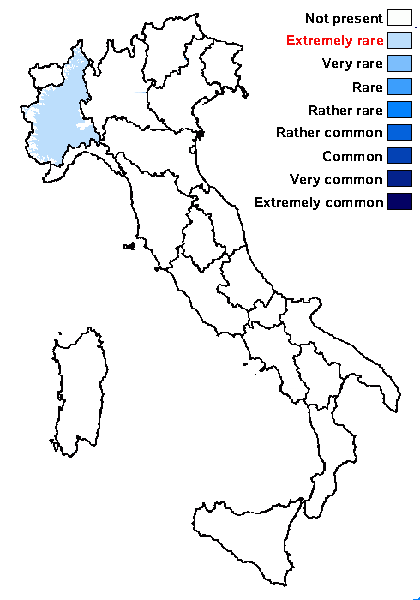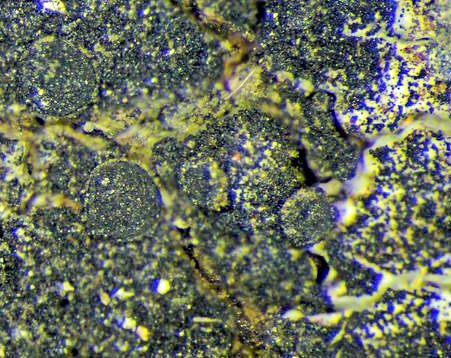Halecania spodomela (Nyl.) M. Mayrhofer
Herzogia, 7: 402, 1987. Basionym: Lecanora spodomela Nyl. - Flora, 59: 572, 1876.
Synonyms: Lecania spodomela (Nyl.) A.L. Sm.; Lecidea nigrificans Nyl.
Distribution: N - Piem.
Description: Thallus crustose, episubstratic, grey-white but often appearing black due to a covering of cyanobacteria, consisting of a few scattered granules, always growing on cyanobacterial lichens, especially Placynthium-species. Apothecia lecanorine, sessile, 0.2-0.6 mm across, with a flat to convex, black disc, a thin, entire, often finally excluded thalline margin, and a more or less evident parathecial ring. Thalline exciple indistinctly corticated, with many algae in the medulla; proper exciple paraplectenchymatous, dark brown in outer part, paler within, N-; epithecium mottled green to green-black, K-, N+ red; hymenium colourless, 65-85 µm high, I+ blue; paraphyses coherent, sparingly branched in upper part, the apical cells hardly swollen, only a few with a dark cap; hypothecium colourless. Asci 8-spored, clavate to subcylindrical, with a K/I+ blue outer coat and a K/I+ uniformly blue apical dome, Catillaria-type. Ascospores 1-septate, hyaline, ellipsoid, 10-15 x 5-7.5 µm, including the gelatinous perispore. Pycnidial wall green in upper part, N+ red. Conidia hyaline, bacilliform. Photobiont chlorococcoid. Spot tests: thallus K-, C-, KC-, P-, UV-. Chemistry: without lichen substances.Note: a species resembling H. alpivaga, but with a strongly reduced thallus and smaller apothecia, found on siliceous rocks, usually growing on Placynthium; in western Europe it is mainly coastal, and the central and eastern European historical records are in need of critical re-evaluation.
Growth form: Crustose
Substrata: rocks
Photobiont: green algae other than Trentepohlia
Reproductive strategy: mainly sexual
Most common in areas with a humid-warm climate (e.g. most of Tyrrenian Italy)
Commonnes-rarity: (info)
Alpine belt: absent
Subalpine belt: absent
Oromediterranean belt: absent
Montane belt: extremely rare
Submediterranean belt: extremely rare
Padanian area: absent
Humid submediterranean belt: absent
Humid mediterranean belt: absent
Dry mediterranean belt: absent

Predictive model
Growth form: Crustose
Substrata: rocks
Photobiont: green algae other than Trentepohlia
Reproductive strategy: mainly sexual
Most common in areas with a humid-warm climate (e.g. most of Tyrrenian Italy)
Commonnes-rarity: (info)
Alpine belt: absent
Subalpine belt: absent
Oromediterranean belt: absent
Montane belt: extremely rare
Submediterranean belt: extremely rare
Padanian area: absent
Humid submediterranean belt: absent
Humid mediterranean belt: absent
Dry mediterranean belt: absent

Predictive model
 INDEX FUNGORUM
INDEX FUNGORUM
 GBIF
GBIF



